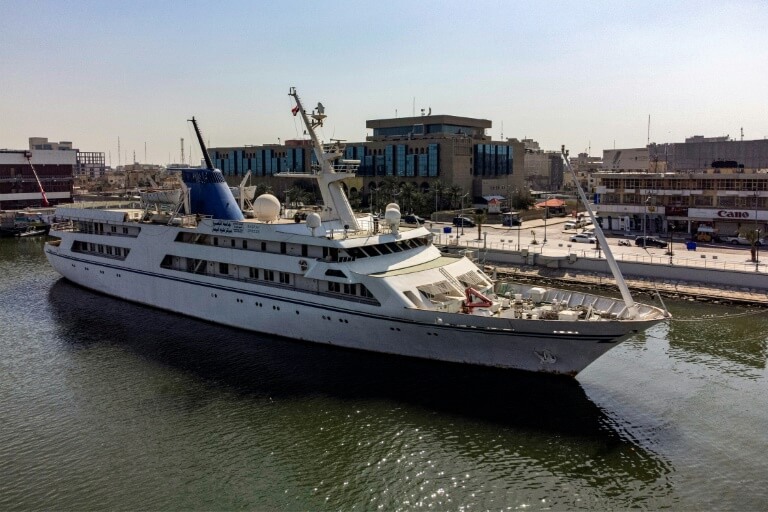Saddam’s old yachts dock at the junction of Iraq’s Tigris and Euphrates rivers

The Basrah Breeze is currently under the jurisdiction of the University of Basra’s maritime science centre, which is conducting research on it
Basra – Frozen in time for 20 years, two superyachts lie at the confluence of Iraq’s Tigris and Euphrates rivers, bearing witness to the false glories of former dictator Saddam Hussein.
Just a few hundred metres separate the grandiose vessels on the Shatt al-Arab waterway in Iraq’s southern city of Basra, but despite their proximity, they have met very different fates.
The Al-Mansur (Victorious) now lays on its side, having capsized after it was struck during the 2003 US-led invasion of Iraq that ended Saddam’s decades of iron-fisted rule.
Moored at a nearby quay, the Basrah Breeze — equipped with swimming pools and at one time a missile launcher — is by contrast partially open to curious spectators eager to board this relic of the war-scarred country’s past.
“Everyone who comes is amazed by the luxury of the yacht,” said Sajjad Kadhim, an instructor at the University of Basra’s maritime science centre, which now has jurisdiction over the boat as part of a project to study it.
But to the surprise of many visitors, Saddam never sailed aboard the Basrah Breeze, which at a length of 82 metres (90 yards) was just one example of the former ruler’s extravagance.
The interior of the vessel is like a time capsule, bearing all the gilded trimmings typical of the late strongman’s vast collection of properties.
The yacht’s presidential suite is decorated in golden and cream tones with a king-sized canopy bed and plush, 18th-century style armchairs, while the vast bathrooms are embellished with golden faucets.
During his nearly 24 years in power, Saddam was not known to spare any expense, and the Basrah Breeze, delivered in 1981, was no exception.
With a capacity to board nearly 30 passengers and 35 crew members, the boat has 13 rooms, three lounge areas and a helipad.
Perhaps most impressive is a secret corridor leading to a submarine, offering an escape from any imminent threats, as noted on an information panel on the boat.
“While the Iraqi people were living through the horrors of war and an embargo, Saddam owned such a ship,” said Kadhim, 48, decrying the “wastefulness of the former regime”.
Fearing the repercussions of the Iran-Iraq war during the 1980s, Saddam had given the boat to Saudi Arabia, before it travelled on to Jordan, Kadhim explained.
By 2007, the vessel had come to be moored in Nice, France, where a year later it became the centre of a protracted legal dispute.
Iraqi authorities had claimed ownership over the Basrah Breeze after having discovered plans to sell it for nearly $35 million by a company registered in the Cayman Islands.
With its claim to the boat finally recognised, the Iraqi government in 2009 decided to moor the boat in Basra, having been unable to sell it.
“What I like is the old equipment, the fax and the old telephones in the cockpit,” university professor Abbas al-Maliki told AFP. “It reminds me of the pre-internet era.”
The state of the Basrah Breeze is a far cry from the Al-Mansur, half-submerged, its rusty carcass protruding from the waters of Shatt al-Arab.
Measuring 120 metres in length and weighing more than 7,000 tonnes, the former presidential yacht had been assembled in Finland and delivered to Iraq in 1983, according to the website of Danish designer Knud E. Hansen.
It has a capacity of 32 passengers and 65 crew members.
In the period just before the US-led invasion two decades ago, the Al-Mansur had been moored in the Gulf.
But Saddam would later send it up along Shatt al-Arab “to protect it from bombardment by American planes”, according to maritime engineer Ali Mohamed.
“This was a failure,” he added.
According to Basra’s former chief of heritage Qahtan al-Obeid, in March 2003 “several raids were launched on the yacht over a number of days.
“It was bombed at least three times, but it never sank,” he said.
In pictures taken by an AFP photographer in 2003, Al-Mansur can be seen still floating on the water, its top floors charred from a fire that erupted due to the bombing.
But by June of that year, the boat was already tipping precariously.
It fell over “when the motors were stolen. This created openings and the water rushed in, causing it to lose balance,” Obeid said.
But Al-Mansur “is a very big boat, it has to be dismantled then removed,” said Obeid — a process that would be “costly and difficult”.
